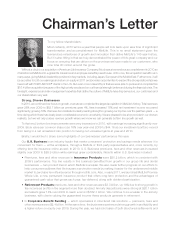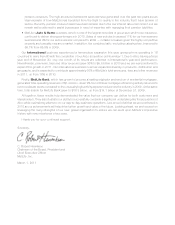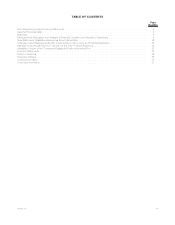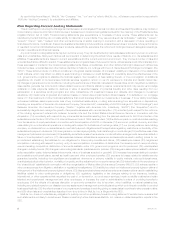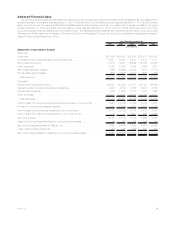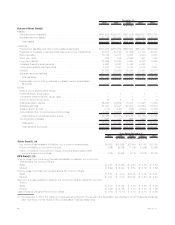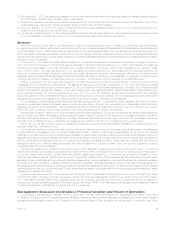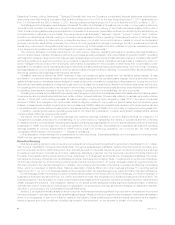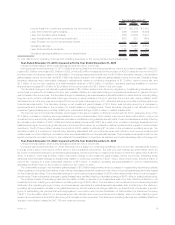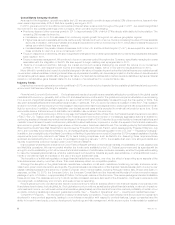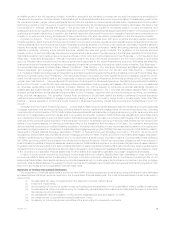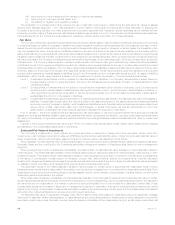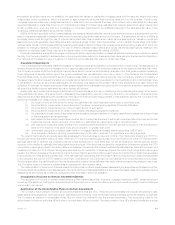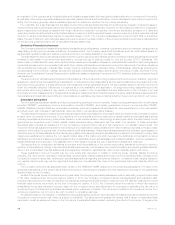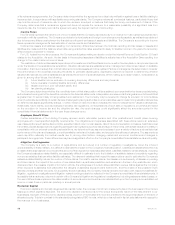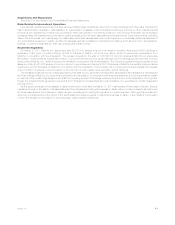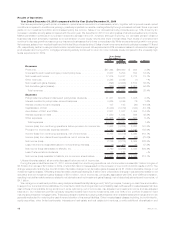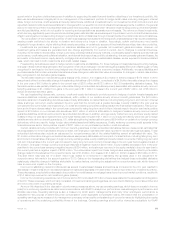MetLife 2010 Annual Report Download - page 12
Download and view the complete annual report
Please find page 12 of the 2010 MetLife annual report below. You can navigate through the pages in the report by either clicking on the pages listed below, or by using the keyword search tool below to find specific information within the annual report.profitable growth in the life insurance industry. In addition, several of the industry’s products can be quite homogeneous and subject to
intense price competition. Sufficient scale, financial strength and financial flexibility are becoming prerequisites for sustainable growth in the
life insurance industry. Larger market participants tend to have the capacity to invest in additional distribution capability and the information
technology needed to offer the superior customer service demanded by an increasingly sophisticated industry client base. We believe that
the turbulence in financial markets that began in the second half of 2007, its impact on the capital position of many competitors, and
subsequent actions by regulators and rating agencies have highlighted financial strength as a significant differentiator from the perspective of
customers and certain distributors. In addition, the financial market turbulence and the economic recession have led many companies in our
industry to re-examine the pricing and features of the products they offer and may lead to consolidation in the life insurance industry.
Regulatory Changes. The U.S. life insurance industry is regulated at the state level, with some products and services also subject to
Federal regulation. As life insurers introduce new and often more complex products, regulators refine capital requirements and introduce new
reserving standards for the life insurance industry. Regulations recently adopted or currently under review can potentially impact the statutory
reserve and capital requirements of the industry. In addition, regulators have undertaken market and sales practices reviews of several
markets or products, including equity-indexed annuities, variable annuities and group products. The regulation of the financial services
industry in the U.S. and internationally has received renewed scrutiny as a result of the disruptions in the financial markets in 2008 and 2009.
Significant regulatory reforms have been proposed and these or other reforms could be implemented. See “Business — U.S. Regulation” and
“Business — International Regulation.” We cannot predict whether any such reforms will be adopted, the form they will take or their effect
upon us. We also cannot predict how the various government responses to the recent financial and economic difficulties will affect the
financial services and insurance industries or the standing of particular companies, including us, within those industries. See “Business —
Governmental Responses to Extraordinary Market Conditions,” “Risk Factors — Our Insurance, Brokerage and Banking Businesses Are
Heavily Regulated, and Changes in Regulation May Reduce Our Profitability and Limit Our Growth” and “Risk Factors — Changes in
U.S. Federal and State Securities Laws and Regulations, and State Insurance Regulations Regarding Suitability of Annuity Product Sales, May
Affect Our Operations and Our Profitability.” Until various studies are completed and final regulations are promulgated pursuant to Dodd-
Frank, the full impact of Dodd-Frank on the investments, investment activities and insurance and annuity products of the Company remain
unclear. See “Risk Factors — Various Aspects of Dodd-Frank Could Impact Our Business Operations, Capital Requirements and Profitability
and Limit Our Growth.” Under Dodd-Frank, as a large, interconnected bank holding company with assets of $50 billion or more, or possibly as
an otherwise systemically important financial company, MetLife, Inc. will be subject to enhanced prudential standards imposed on
systemically significant financial companies. Enhanced standards will be applied to Tier 1 and total risk-based capital (“RBC”), liquidity,
leverage (unless another, similar standard is appropriate for the Company), resolution plan and credit exposure reporting, concentration
limits, and risk management. The so-called “Volcker Rule” provisions of Dodd-Frank restrict the ability of affiliates of insured depository
institutions (such as MetLife Bank) to engage in proprietary trading or sponsor or invest in hedge funds or private equity funds. See “Risk
Factors — Various Aspects of Dodd-Frank Could Impact Our Business Operations, Capital Requirements and Profitability and Limit Our
Growth.”
Mortgage and Foreclosure-Related Exposures. In 2008 MetLife Bank acquired certain assets to enter the forward and reverse residential
mortgage origination and servicing business, including rights to service residential mortgage loans. At various times since then, including
most recently in the third quarter of 2010, MetLife Bank has acquired additional residential mortgage loan servicing rights. As an originator and
servicer of mortgage loans, which are usually sold to an investor shortly after origination, MetLife Bank has obligations to repurchase loans
upon demand by the investor due to (i) a determination that material representations made in connection with the sale of the loans (relating, for
example, to the underwriting and origination of the loans) are incorrect or (ii) defects in servicing of the loan. MetLife Bank is indemnified by the
sellers of the acquired assets, for various periods depending on the transaction and the nature of the claim, for origination and servicing
deficiencies that occurred prior to MetLife Bank’s acquisition, including indemnification for any repurchase claims made from investors who
purchased mortgage loans from the sellers. Substantially all mortgage servicing rights (“MSRs”) that were acquired by MetLife Bank relate to
loans sold to Federal National Mortgage Association (“FNMA”) or Federal Home Loan Mortgage Corporation (“FHLMC”). Since the 2008
acquisitions, MetLife Bank has originated and sold mortgages primarily to FNMA, FHLMC and Government National Mortgage Association
(“GNMA”) (collectively, the “Agency Investors”) and, to a limited extent, a small number of private investors. Currently 99% of MetLife Bank’s
$83 billion servicing portfolio is comprised of products sold to Agency Investors. Other than repurchase obligations which are subject to
indemnification by sellers of acquired assets as described above, MetLife Bank’s exposure to repurchase obligations and losses related to
origination deficiencies is limited to the approximately $52 billion of loans originated by MetLife Bank (all of which have been originated since
August 2008) and to servicing deficiencies after the date of acquisition, and management is satisfied that adequate provision has been made
in the Company’s consolidated financial statements for all probable and reasonably estimable repurchase obligations and losses.
In light of recent events concerning foreclosure proceedings within the industry, MetLife Bank has undertaken a close review of its
procedures. MetLife Bank verifies the accuracy of borrower information included in affidavits filed in foreclosure proceedings. We do not
believe that MetLife Bank has material exposure to potential losses arising from challenges to its foreclosure procedures. Like other mortgage
servicers, MetLife Bank has been the subject of recent inquiries and investigations from state attorneys general and banking regulators. See
Note 16 of the Notes to the Consolidated Financial Statements.
Summary of Critical Accounting Estimates
The preparation of financial statements in conformity with GAAP requires management to adopt accounting policies and make estimates
and assumptions that affect amounts reported in the consolidated financial statements. The most critical estimates include those used in
determining:
(i) the estimated fair value of investments in the absence of quoted market values;
(ii) investment impairments;
(iii) the recognition of income on certain investment entities and the application of the consolidation rules to certain investments;
(iv) the estimated fair value of and accounting for freestanding derivatives and the existence and estimated fair value of embedded
derivatives requiring bifurcation;
(v) the capitalization and amortization of DAC and the establishment and amortization of VOBA;
(vi) the measurement of goodwill and related impairment, if any;
(vii) the liability for future policyholder benefits and the accounting for reinsurance contracts;
9MetLife, Inc.


